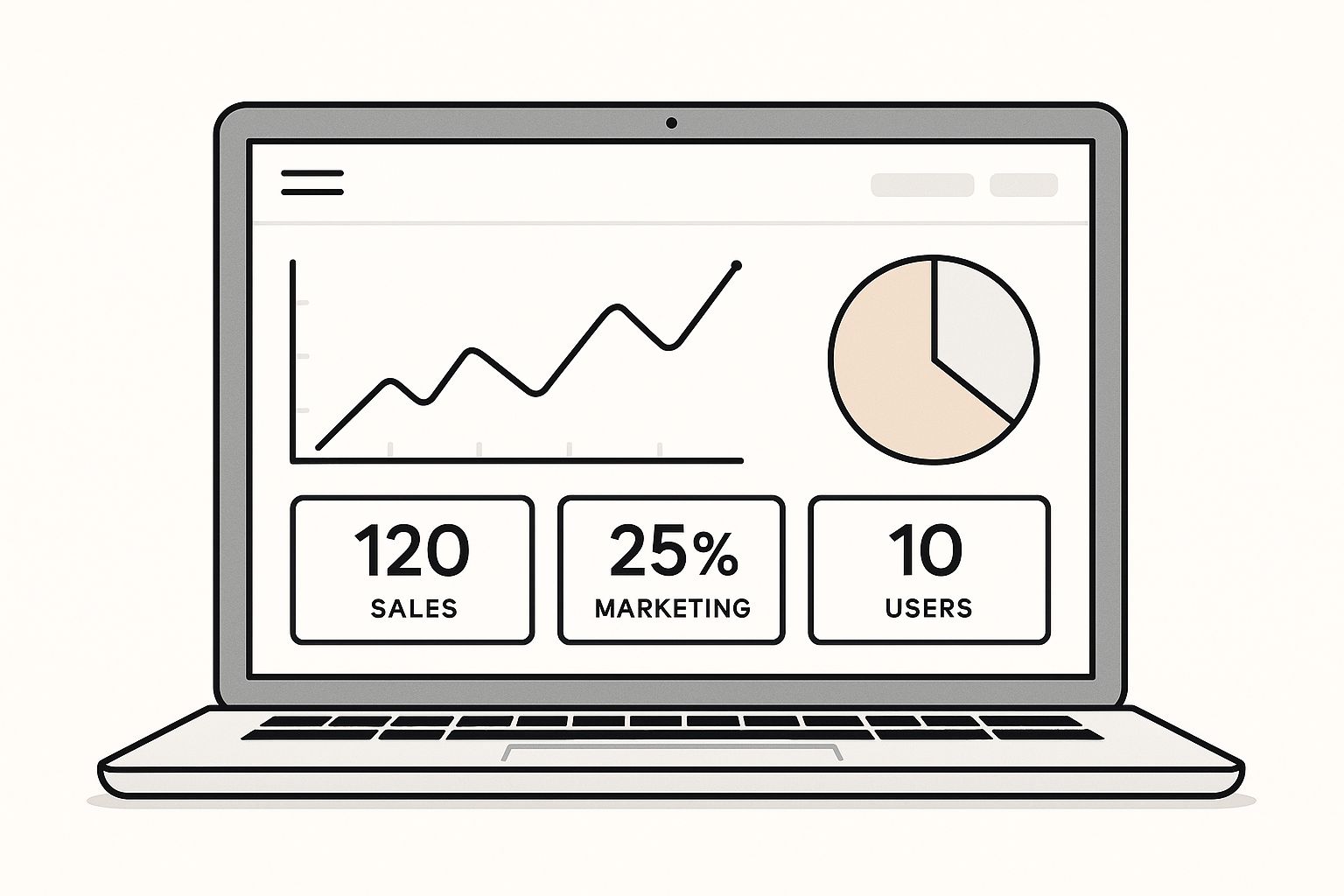
Digital Marketing Performance Metrics: Complete Guide
Sections
- Understanding Digital Marketing Performance Metrics
- Core Engagement And Conversion Metrics That Matter
- Traffic And Acquisition Metrics For Growth
- Content Marketing Performance Measurement
- Revenue-Focused Performance Indicators
- SEO And SEM Performance Tracking
- Building Your Performance Measurement Framework
#Understanding Digital Marketing Performance Metrics
Think of digital marketing performance metrics as your business’s vital signs. Just as a doctor checks your pulse and blood pressure to understand your health, marketers use specific metrics to see what’s working and what needs attention. This data-first approach isn’t just a good idea; it’s essential. With the global digital advertising market expected to hit around $843 billion by 2025, every dollar spent needs to be accounted for. You can find more marketing statistics that show just how important these numbers are for any business.
#From Vanity Metrics to Actionable Insights
One of the biggest traps for any business is focusing on vanity metrics. These are the numbers that look impressive on paper—like a high number of social media followers or page likes—but don’t actually contribute to your core business goals. They give you a false sense of accomplishment without telling you anything about revenue or real growth. The key is to move from these feel-good numbers to insights that connect your marketing actions directly to your bottom line.
Imagine a company celebrating 100,000 followers on its social media page. That sounds great, right? But if that massive audience never clicks, buys, or even engages with the content, the number is hollow. An actionable metric, on the other hand, would be the conversion rate from a specific social media campaign, which clearly links your marketing spend to actual sales. This is the difference between being busy and being effective.
A well-designed dashboard helps you cut through the noise and focus on what truly drives performance, leaving vanity metrics behind.

This kind of visual overview instantly highlights key performance indicators (KPIs) like conversion rates, cost per acquisition, and traffic sources, giving you a clear picture of what’s producing results.
#The Goal: Strategic Measurement, Not Metric Obsession
The aim isn’t to track every single metric you can find. That path leads to “analysis paralysis,” where you’re so buried in data that you can’t make a clear decision. Instead, the focus should be on strategic measurement, which means picking the handful of KPIs that align directly with your most important business objectives.
To do this, you need to ask some pointed questions:
- What is the main purpose of this campaign? Is it to generate leads, drive direct sales, or build brand awareness?
- Which single metric best shows our progress toward that specific goal?
- How can we use what we learn from this metric to make smarter decisions in the next quarter?
By concentrating on what really matters, you can use your digital marketing performance metrics as a reliable compass, guiding every decision toward sustainable growth and measurable revenue.
#Core Engagement And Conversion Metrics That Matter
While getting traffic to your website feels like a win, it’s only half the story. Think of it like a busy storefront—lots of people walking in is great, but if no one interacts with the products or speaks to the staff, something is wrong. Traffic metrics tell you how many people arrive, but engagement metrics reveal what they do once they’re inside.
High traffic with low engagement often signals a mismatch between what your audience expects and what you’re actually offering. This is where focusing on the right digital marketing performance metrics helps you understand what your visitors are truly looking for and what they might do next.
This dashboard shows how to visualize key engagement and conversion metrics for a quick, at-a-glance analysis of your campaign’s health.

By combining high-level trends with specific KPI tiles, you can easily spot which areas need immediate attention and which are performing well.
#Key Engagement Metrics To Monitor
It’s easy to get caught up in “vanity metrics” like likes and shares. Instead, it’s more productive to track interactions that show genuine interest and lay the groundwork for conversions. These are the real signals that your content is hitting the mark.
Here are a few essential ones to watch:
- Time on Page / Session Duration: This is a powerful sign of content value. If visitors are spending several minutes on a page, it’s a clear indication that your content is compelling and holds their attention.
- Pages Per Session: This metric tracks how many different pages a user visits in one go. A high number suggests they are exploring your site deeply, moving beyond the first page they landed on.
- Scroll Depth: Knowing how far down a page a user scrolls tells you how much of your content they actually read. A 75% scroll depth is a much stronger indicator of interest than a simple page view.
- Engagement Rate: This metric bundles multiple interactions (like clicks, scrolls, and time on page) into one score. It’s especially important for video content; recent data reveals that 60% of video marketers consider engagement rate their most important KPI.
#From Engagement To Conversion
Ultimately, the goal is to turn visitor engagement into meaningful action. This is where conversion metrics take center stage. A conversion isn’t always a sale—it can be any valuable action a user takes, like signing up for a newsletter, downloading a guide, or booking a demo.
To help understand which metrics matter most, the following table breaks down key KPIs by their importance to marketers and their direct effect on business goals.
| Metric | Marketer Priority (%) | Business Impact | Calculation Method |
|---|---|---|---|
| Conversion Rate | 81% | High | Directly measures how many visitors complete a desired action (e.g., purchase, form fill). Crucial for revenue. |
| Customer Lifetime Value (CLV) | 75% | Very High | Predicts the total revenue a business can expect from a single customer account. Guides long-term strategy. |
| Return on Ad Spend (ROAS) | 72% | High | Shows the revenue generated for every dollar spent on advertising. Essential for budget allocation. |
| Engagement Rate | 60% | Medium | Measures how actively involved an audience is with content. A leading indicator of future conversions. |
| Cost Per Acquisition (CPA) | 58% | High | Calculates the total cost to acquire a new paying customer. Key for profitability analysis. |
| Click-Through Rate (CTR) | 44% | Medium | Indicates how effective your ads or titles are at grabbing attention. Affects traffic quality and cost. |
This table highlights a clear trend: marketers prioritize metrics like Conversion Rate and CLV because they are directly tied to revenue and profitability. While metrics like Engagement Rate are important, their main function is to predict and drive the actions that have a more direct business impact.
Platforms like Google Analytics provide clear reports on how many users complete these actions, showing which channels are your top performers. By tracking both small commitments (micro-conversions like newsletter sign-ups) and major ones (macro-conversions like purchases), you can map the entire customer journey and pinpoint which engagement patterns most often lead to a sale.
#Traffic And Acquisition Metrics For Growth
Think of your website’s traffic sources as a map of your customer’s journey. This map reveals which routes are bustling highways leading straight to your business and which are quiet side streets. Simply knowing how many people show up isn’t enough; you need to understand who they are and where they came from. Focusing on the right digital marketing performance metrics helps you distinguish between visitors who are just browsing and those who become paying customers.
This level of detail uncovers the true cost and value of each marketing channel. A dashboard, like the one you can find in Google Analytics, breaks down your traffic by source, medium, and campaign, giving you a clear view of your performance.

This kind of report helps you see exactly which channels are driving not just visits, but engaged users who contribute to your bottom line.
#Key Traffic and Acquisition Metrics
To get a complete picture, you need to look beyond raw session counts. These metrics offer deeper insights into the quality and cost-effectiveness of your traffic, helping you spend your marketing budget wisely.
- Traffic by Source/Channel: This is the starting point. It tells you where your visitors originate—be it organic search, social media, paid ads, or referrals. It answers the basic question: “Which platforms are actually sending people my way?”
- Customer Acquisition Cost (CAC): This is the total amount you spend on sales and marketing to gain a single new customer. You calculate it by dividing your total acquisition costs by the number of new customers you brought in over a set period. Keeping CAC low is fundamental for profitable growth.
- New vs. Returning Visitors: This metric is a great indicator of audience loyalty. A high number of returning visitors suggests your content is sticky and your brand is memorable. On the other hand, a healthy flow of new visitors shows that your marketing efforts are expanding your reach.
#Building a Smarter Strategy
Your ultimate goal is to create a mix of channels that delivers both immediate wins and long-term growth. By understanding which sources bring in high-value visitors at an acceptable cost, you can make smarter decisions. For instance, if organic search consistently delivers engaged users, it might be a good time to learn how to optimize your site for a wide range of search queries and double down on what works. This approach ensures every dollar you invest in generating traffic produces a real, measurable return.
#Content Marketing Performance Measurement
While seeing traffic and engagement numbers climb is exciting, measuring your content marketing performance goes much deeper. It’s about understanding the story your content tells and how well that narrative connects with your audience. Think of each blog post, video, or guide as a salesperson working for you 24/7. The real question is: which of these “salespeople” are just making small talk, and which ones are actually guiding people toward becoming customers?
This means we need to look past simple metrics like shares and likes. True content performance measurement connects what people read, watch, or download to real business goals. You need to know which articles build that first spark of awareness, which case studies build trust, and which ultimate guides push prospects to make a decision. This is critical because content remains a foundational part of any digital strategy. In fact, a study shows 84% of B2B marketers have successfully used content to build brand awareness, highlighting its massive impact. You can dive into more digital marketing statistics to see how content is shaping business today.
#Tracking Content’s Full-Funnel Impact
To truly measure content’s success, you have to track its influence across the entire customer journey. A single metric won’t give you the full picture. Instead, you need a mix of indicators that align with each stage of the marketing funnel.
Here’s a simple breakdown of key metrics to watch at each stage:
- Top-of-Funnel (Awareness): At this initial stage, you’re trying to attract new eyes. Focus on metrics like organic traffic to your blog, the number of impressions your content gets, and how many new users find you through your articles or videos. These numbers show how well you’re casting your net.
- Middle-of-Funnel (Consideration): Now, you’re looking for signs of genuine interest. Track metrics that show deeper engagement, such as time on page, scroll depth, and downloads of gated content like ebooks or whitepapers. A high download rate for a guide is a great sign—it means your content has built enough trust for someone to share their contact info.
- Bottom-of-Funnel (Decision): This is where content meets revenue. Use metrics like the lead-to-customer conversion rate for leads that came from a specific piece of content. You can also track content-assisted conversions, which show how many paying customers interacted with an article or video at some point before making a purchase.
The screenshot below shows how to organize these metrics based on their role in the marketing funnel, from creating awareness to driving action.
This framework helps you connect specific content pieces to real business outcomes. By organizing your digital marketing performance metrics this way, you can clearly demonstrate your content’s value and make a strong case for continued investment by showing its direct contribution to the bottom line.
#Revenue-Focused Performance Indicators
While seeing more traffic and likes feels good, revenue-focused performance indicators are what really connect your marketing work to business growth. These metrics cut through the vanity stats and draw a straight line from a campaign to its financial impact. This is where the rubber meets the road, and it’s a spot where many businesses stumble.
The goal is simple: create a clear feedback loop between what you spend on marketing and what comes back into the business.
#Measuring The Real Return
Let’s talk about two of the most important revenue-focused metrics: Customer Lifetime Value (CLV) and Return on Ad Spend (ROAS). These go beyond just counting sales to show you the real profitability of your marketing.
- Customer Lifetime Value (CLV): Think of this as the total amount of money you expect to make from a single customer throughout their entire relationship with you. It shifts your thinking from a single transaction to building long-term loyalty. A high CLV is a fantastic sign that you’re not just getting customers, but keeping them happy.
- Return on Ad Spend (ROAS): This one is very direct. It calculates the revenue you earn for every dollar you put into advertising. For example, a ROAS of 5:1 means you brought in $5 for every $1 you spent. It’s a critical measure for understanding which ad campaigns are actually making money and where to put your budget next.
The chart below from Salesforce gives a great visual of how Marketing ROI is calculated, offering a simple framework for tracking the financial return on your marketing dollars.
As the image shows, the math is straightforward. Tracking this ensures your campaigns are pulling their weight and generating real value for your business.
#Advanced Attribution And Long-Term Value
In today’s world, it’s rare for a customer to see one ad and immediately buy. Their journey often involves multiple touchpoints. This is where attribution modeling becomes essential. Instead of giving 100% of the credit to the very last click before a purchase (last-touch attribution), smarter models spread the credit out.
Imagine a customer’s journey: they first read a blog post, later see a social media ad, and finally click a Google search ad to buy. A linear attribution model, for instance, would give equal credit to each of those steps. This acknowledges that your brand-building content and early-funnel efforts are just as important as the final click.
This holistic view helps you understand the true value of every marketing activity. You can get even more specific with your SEO by learning how to use an opportunity score to maximize your SEO chances, which helps pinpoint keywords that are most likely to bring in valuable traffic. By mastering these revenue-focused metrics, you can make smarter, data-backed decisions that consistently boost your bottom line.
#SEO And SEM Performance Tracking
Search Engine Optimization (SEO) and Search Engine Marketing (SEM) are the two core methods for boosting your visibility in search results. Think of it this way: SEO is like planting an orchard. It requires patience and nurturing, but over time, it yields a consistent, organic harvest for years to come. SEM, on the other hand, is like setting up a stall at a farmer’s market. You can start selling your produce right away, see what’s popular, and generate immediate revenue. The strongest strategies don’t choose one over the other—they use both together.
To gauge your success, you need to track digital marketing performance metrics that measure both long-term growth and short-term efficiency. If you’re just starting out, building a strong foundation is key. You can explore a beginner’s guide to search engine optimization to get comfortable with the core concepts before diving deeper.
#Key SEO Metrics for Long-Term Authority
With SEO, the main objective is to build sustainable, organic traffic. The metrics you monitor should reflect this marathon, not a sprint.
- Keyword Rankings: Watching your position for target keywords shows your growing authority online. The goal isn’t just to rank, but to see a steady upward climb for queries that show a user is ready to act.
- Organic Traffic: This is the lifeblood of any SEO strategy. It’s not enough to just count visitors from search engines; you also need to see what they do. Are they staying on your site and interacting with your content? That’s a sign of true success.
- Backlink Profile Quality: This metric evaluates the number and authority of other websites that link to yours. High-quality backlinks are like powerful votes of confidence, telling search engines your content is credible and trustworthy.
The image below breaks down how these different pieces of the SEO puzzle fit together to boost a website’s visibility.
As this visual shows, a successful SEO approach combines a solid technical setup, valuable content, and authority-building links to climb the search rankings.
#Essential SEM Metrics for Immediate Impact
When it comes to SEM, or paid search, the focus shifts to efficiency and a quick return on your ad spend.
- Click-Through Rate (CTR): This tells you how well your ad copy and targeting resonate with your audience. A high CTR means your ads are hitting the mark and are relevant to what people are searching for.
- Cost Per Click (CPC): Keeping a close eye on how much you pay for each click is crucial for managing your budget. It ensures you’re getting traffic without overspending.
- Conversion Rate: This is the ultimate yardstick for SEM success. It reveals the percentage of people who clicked your ad and then completed a desired action, like signing up for a newsletter or making a purchase.
#Building Your Performance Measurement Framework
Think of creating a performance measurement framework as designing a custom dashboard for your car. You wouldn’t drive a race car with only a speedometer; you’d want gauges for oil pressure, engine temperature, and fuel levels. Similarly, your business needs a tailored dashboard that shows the right information at the right time, helping you make quick, confident decisions without getting overwhelmed by data.
A solid framework is a balancing act. It gives you a complete picture without causing “analysis paralysis,” where you have too much data to make a choice. It also prevents you from making risky moves based on incomplete information. Building one means aligning your data with your business goals, connecting your tools, and guiding your strategy.
#Establish Your Foundation
The first step is to connect every metric you track directly back to your core business objectives. This vital step prevents you from drowning in a sea of “vanity metrics” that look good but don’t actually move the needle. From there, you can set realistic benchmarks based on your industry and past performance. This isn’t just about paperwork; it’s about setting clear, ambitious targets for growth.
Here’s how to lay that groundwork:
- Define Core Objectives: Pinpoint exactly what you want to achieve. Are you focused on generating leads, driving direct sales, or building brand awareness? Each goal requires a different set of metrics.
- Select Relevant KPIs: Choose the digital marketing performance metrics that directly measure progress toward your objectives. If your primary goal is sales, you’ll want to focus on Conversion Rate and Customer Lifetime Value (CLV), not just website traffic.
- Integrate Your Tools: Connect your analytics platforms, CRM, and ad managers. The goal is to create a single, reliable source of truth so you’re not juggling conflicting data from different systems.
#Visualize Your Data for Clarity
Once your foundation is solid, you need a way to see what’s happening at a glance. This is where data visualization comes in. Tools that create custom reports can turn complex spreadsheets into easy-to-understand charts and graphs.
Imagine a dashboard that pulls data from multiple channels into one view, giving you a complete picture of your marketing performance.
This kind of report lets you monitor key performance indicators (KPIs) from different campaigns side-by-side. You can spot positive trends to double down on or identify problems before they become serious issues. This systematic approach transforms your metrics from simple reporting numbers into strategic assets that actively drive growth.
By building a measurement framework, you turn raw data into a clear roadmap for success. To dig deeper into your website’s performance and uncover high-potential keywords, check out the powerful analytics tools available at Rankdigger.

